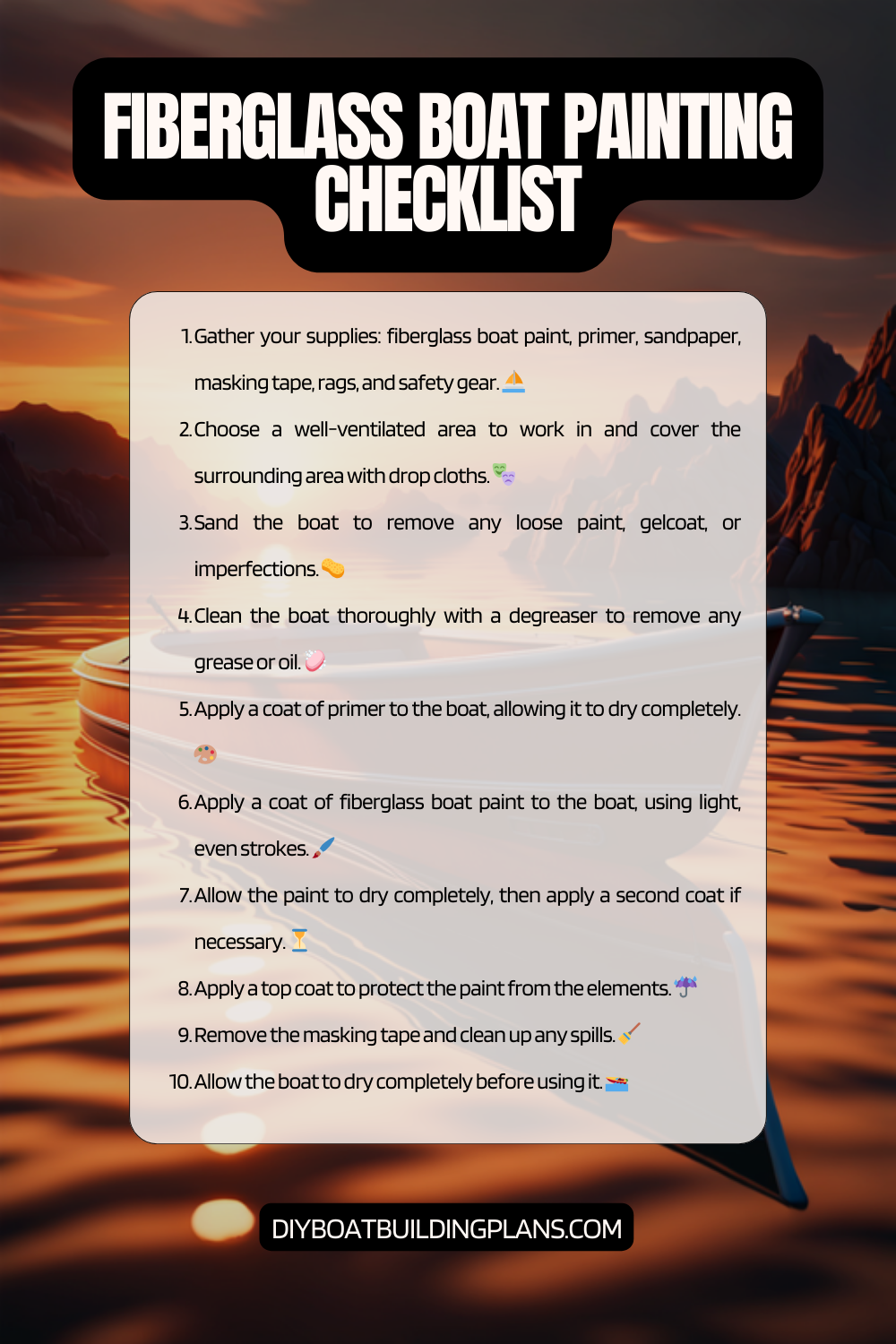Overview of Fiberglass Boat Painting Tips
Maintaining the paint job on a fiberglass boat is crucial for both its aesthetic appeal and its overall longevity. The paint not only enhances the boat’s appearance but also acts as a protective layer against the harsh elements of the water. Without proper maintenance, the paint can fade, chip, and peel, leaving the fiberglass vulnerable to damage. Painting a fiberglass boat not only restores its beauty but also provides a layer of protection that can extend its lifespan.
Key Takeaways
- Proper preparation is key to achieving a smooth and long-lasting paint job on your fiberglass boat.
- Choose a marine-grade paint that is specifically designed for use on fiberglass boats.
- Applying a primer before painting can help improve adhesion and durability of the paint.
- Protect your boat’s paint job from UV damage by using a high-quality wax or UV-resistant coating.
- Regular maintenance and touch-ups can help extend the life of your fiberglass boat’s paint job.

Preparing the Boat for Painting
Before diving into the painting process, it is essential to prepare the boat properly. This involves several steps, starting with cleaning the surface thoroughly. Any dirt, grime, or residue must be removed to ensure proper adhesion of the paint. Additionally, sanding the surface is crucial to create a rough texture that allows the paint to adhere better.
If there is any old paint or coatings on the boat, it is vital to remove them completely. This can be done using sandpaper or a chemical paint stripper, depending on the type of paint and its condition. It is important to note that any damaged areas on the fiberglass should be repaired before painting. This includes filling in cracks or holes and smoothing out any imperfections.
Choosing the Right Paint for Your Fiberglass Boat
Selecting the right paint for your fiberglass boat is essential for achieving a long-lasting and visually appealing result. There are various types of paint available for fiberglass boats, including one-part polyurethane, two-part polyurethane, and epoxy-based paints. Each type has its own advantages and considerations.
When choosing a paint, factors such as durability, color options, and ease of application should be taken into account. One-part polyurethane paints are popular due to their ease of use and wide range of color choices. Two-part polyurethane paints offer superior durability but require more expertise in application. Epoxy-based paints are known for their excellent adhesion and resistance to water, but they can be more challenging to work with.
Consider your specific needs and preferences when selecting the best paint for your fiberglass boat. Consulting with professionals or experienced boaters can provide valuable insights and recommendations.
Applying Primer to Your Fiberglass Boat
| Step | Description |
|---|---|
| 1 | Clean the surface of the fiberglass boat with soap and water to remove any dirt or debris. |
| 2 | Sand the surface of the fiberglass boat with a fine-grit sandpaper to create a rough surface for the primer to adhere to. |
| 3 | Apply a coat of fiberglass primer to the surface of the boat using a paintbrush or roller. |
| 4 | Allow the primer to dry completely before applying a second coat. |
| 5 | Sand the surface of the boat again with a fine-grit sandpaper to smooth out any rough spots or imperfections. |
| 6 | Apply a topcoat of paint or gelcoat to the surface of the boat to protect the fiberglass and give it a finished look. |
Using primer before painting is crucial for achieving a smooth and long-lasting finish on a fiberglass boat. Primer acts as a bonding agent between the paint and the surface, ensuring better adhesion and durability. It also helps to seal any imperfections on the fiberglass, providing a smoother surface for the paint.
Before applying primer, make sure the surface is clean and dry. Apply the primer evenly using a brush or roller, following the manufacturer’s instructions. It is important to allow sufficient drying time between coats and sanding lightly between each coat to achieve a smooth finish.
Tips for Applying Paint to Your Fiberglass Boat
When it comes to applying paint to a fiberglass boat, proper technique and the right tools are essential. Start by choosing high-quality brushes or rollers specifically designed for marine applications. These tools will help you achieve a smooth and even coat of paint.
Apply the paint in thin layers, allowing each coat to dry completely before applying the next. This will prevent runs, drips, and uneven coverage. It is also important to follow the manufacturer’s instructions regarding drying times and recommended number of coats.
Avoid common mistakes such as overloading the brush or roller with paint, which can lead to drips and uneven application. Take your time and apply the paint with steady strokes, working in small sections at a time.
How to Achieve a Smooth Finish on Your Fiberglass Boat
To achieve a professional-looking paint job on your fiberglass boat, attention to detail is key. Start by ensuring that the surface is clean and free of any debris or dust particles that could mar the finish. Use a tack cloth or a lint-free cloth to remove any remaining dust before applying the paint.
When applying the paint, use long, smooth strokes to create an even finish. Avoid going over the same area multiple times, as this can cause streaks or uneven coverage. Pay close attention to edges and corners, ensuring that the paint is applied evenly and smoothly.
Take your time and be patient throughout the process. It may be tempting to rush, but a smooth finish requires careful application and attention to detail. Remember to allow sufficient drying time between coats and avoid touching or disturbing the paint until it is fully cured.
Dealing with Common Painting Problems on Fiberglass Boats
While painting a fiberglass boat, several common issues can arise. It is important to address these problems promptly to ensure a high-quality finish. One common issue is runs or drips in the paint. If this occurs, carefully sand the affected area once the paint has dried and reapply a thin coat of paint.
Bubbles can also appear in the paint, usually due to trapped air or moisture. If bubbles occur, gently sand the area and apply a new coat of paint. It is important to identify and address the underlying cause of the bubbles, such as moisture or improper surface preparation.
If you encounter any other issues during the painting process, consult with professionals or experienced boaters for guidance. They can provide valuable advice on how to fix specific problems and achieve the desired result.
Maintaining Your Fiberglass Boat’s Paint Job
To keep your fiberglass boat’s paint job looking great over time, regular cleaning and maintenance are essential. Saltwater, sun exposure, and environmental pollutants can all take a toll on the paint’s appearance and durability.
Regularly wash your boat with mild soap and water to remove dirt, salt residue, and other contaminants. Avoid using abrasive cleaners or harsh chemicals that could damage the paint. After washing, apply a coat of wax or polish to protect the paint and enhance its shine.
Inspect the paint regularly for any signs of damage, such as chips or scratches. Promptly address any issues to prevent further damage and maintain the integrity of the paint job. Touch up small areas of damage as needed using the same paint and techniques used during the initial painting process.
Protecting Your Fiberglass Boat from UV Damage
UV rays can cause significant damage to a fiberglass boat’s paint job over time. Fading, discoloration, and loss of gloss are common issues associated with UV exposure. To protect your boat from UV damage, consider using a UV-resistant topcoat or clear coat.
These specialized coatings provide an extra layer of protection against the sun’s harmful rays. They help to prevent fading and discoloration, keeping your boat’s paint job looking vibrant and fresh for longer periods. When selecting a UV-resistant topcoat, ensure that it is compatible with the type of paint used on your fiberglass boat.
In addition to using a UV-resistant topcoat, other measures can be taken to protect your boat from UV damage. Whenever possible, store your boat in a covered area or use a boat cover when it is not in use. This will shield the paint from direct sunlight and minimize exposure to UV rays.
Download over 500 Boat Plans. Click on the link below.
-->Click Here<--
Tips for Touching Up Your Fiberglass Boat’s Paint
Over time, small areas of damage or wear may appear on your fiberglass boat’s paint job. Touching up these areas promptly can help maintain the overall appearance and integrity of the paint. Start by thoroughly cleaning the damaged area and removing any loose or chipped paint.
When touching up small areas, it is important to use the same type of paint that was originally applied. This ensures compatibility and a seamless blend with the existing paint job. Use a small brush or sponge applicator to apply the touch-up paint, taking care to feather the edges for a smooth transition.
Allow the touch-up paint to dry completely before applying any additional coats or protective coatings. Once the touch-up is complete, inspect the area closely to ensure a seamless finish. If necessary, lightly sand and buff the touch-up area to blend it with the surrounding paint.
Fiberglass Boat Painting Checklist

Conclusion – Fiberglass Boat Painting Tips
In conclusion, properly painting and maintaining a fiberglass boat’s paint job is essential for its longevity and visual appeal. By following the steps outlined in this article, you can achieve a professional-looking finish that will protect your boat and enhance its overall appearance.
Remember to take the time and effort to prepare the boat properly before painting, including cleaning, sanding, and repairing any damage. Choose the right paint for your specific needs and apply it using proper techniques and tools. Pay attention to detail and strive for a smooth and even finish.
Regular maintenance, including cleaning, waxing, and touch-ups, will help keep your boat’s paint job looking great over time. Protecting your boat from UV damage is crucial to prevent fading and discoloration. Seek professional help if needed or consult with experienced boaters for guidance throughout the process.
By investing in proper care and maintenance, you can enjoy a beautiful and long-lasting paint job on your fiberglass boat for years to come.
FAQs – Fiberglass Boat Painting Tips
What is fiberglass boat painting?
Fiberglass boat painting is the process of applying paint to the surface of a fiberglass boat to protect it from the elements and enhance its appearance.
Why is it important to paint a fiberglass boat?
Painting a fiberglass boat is important because it helps to protect the boat from the damaging effects of the sun, saltwater, and other environmental factors. It also helps to improve the boat’s appearance and can increase its resale value.
What are some tips for preparing a fiberglass boat for painting?
Some tips for preparing a fiberglass boat for painting include cleaning the surface thoroughly, sanding the surface to create a rough texture for the paint to adhere to, and using a primer to help the paint stick to the surface.
What type of paint should be used for fiberglass boat painting?
The type of paint that should be used for fiberglass boat painting depends on the specific needs of the boat. Some common types of paint include marine-grade enamel, polyurethane, and epoxy.
How many coats of paint should be applied to a fiberglass boat?
The number of coats of paint that should be applied to a fiberglass boat depends on the type of paint being used and the condition of the boat’s surface. Generally, two to three coats of paint are recommended.
How long does it take to paint a fiberglass boat?
The amount of time it takes to paint a fiberglass boat depends on the size of the boat, the condition of the surface, and the type of paint being used. Generally, it can take anywhere from a few days to a few weeks to complete the painting process.



